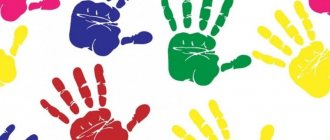Definition of didactics
The word “didactics” is translated from ancient Greek as “educational”. So, when children are taught in an informal play atmosphere, when the child “learns while playing,” experiencing pleasure from the process, this is both a lesson and a game, a didactic game.
A child’s imaginative thinking is directly related to the fact that a little person learns about the world in a playful way.
If you and your child spent the weekend at the zoo, and he was impressed by the orangutan Buba, then get ready for the next few days that all family members will participate in a game called “Buba in the Zoo”.
Imaginative thinking helps a child feel the beauty of the world around him, believe in fairy tales, and develops imagination and creative abilities.
A game for a preschooler is a way of life. And if the game is given an educational focus, then one hundred percent mastery of the material is guaranteed. This is why the didactic game for speech development is so actively used when working with children.
Manual "Digital Puzzles"
This game will interest kids not only during classes, but also at leisure. Making such a guide is very simple, so it is possible to modify and complicate the tasks. For example, you can select images on the topic “Winter”, “Forest Animals”, “Transport” and others. After printing the prepared illustrations, they need to be glued onto cardboard. Then you need to cut the image into several parts and then number them. This creates a puzzle that needs to be assembled from top to bottom from one to the last number.
Thanks to such cognitive activity, the middle group can consolidate knowledge about numbers and counting.
Purpose of the game
Didactic games develop in a child:
- Cognitive skills. The child observes, learns a lot of new things, expands existing knowledge about the world around him, living and inanimate nature.
- Mental capacity. A person learns to think, express his thoughts, construct sentences, reason. And also - remember, compare, evaluate.
- Speech. The vocabulary increases significantly, pronunciation improves, the ability to participate in dialogues and pronounce monologues is formed.
- Moral qualities. The child learns to help, sympathize, restrain himself, and respect others.
- Social adaptation. Skills are acquired such as the ability to conflict, participate in competition, interact with peers, adults, give in to others, and not be offended.
Therefore, if your baby has been asking you to play with him for half an hour, and you have absolutely no time for this, give him a jar of semolina with beans hidden in it, and ask him to prepare dinner for the zoo pets. While you are cooking borscht for dad)).
Thinking through the topic
A plan for how to make a board game with your own hands starts with an idea. And you don’t need to sit and specifically wait for inspiration. Original ideas can come while doing everyday things, walking or with friends. Sometimes it's something relatively new, other times it's an improvement on something that already exists, or a combination of several well-known games.
Inspiration can come from your favorite book, movie, TV show or show. The main thing is to keep a notepad or electronic organizer on hand to write down the ideas that come up.
Types and examples of didactic games for preschoolers
Didactic games differ in content, actions, rules and come in three types:
- games with objects;
- printed board games;
- verbal didactic games.
Their degree of difficulty can be adjusted depending on the age of the participants. The same game can have several variants. For example, kids arrange cards by color; Older children name numbers; and someone can already put the word together.
Games with objects
1. Magic bag
You need to pull out objects of different shapes by touch from the bag: a ball, a cube, a pyramid. Or objects with different textures: pine cone, acorn, chestnut.
2. Rainbow
The child is invited to arrange cubes, mosaics, and pyramids by color.
During didactic games with objects, the child learns to think, analyze, compare objects with each other, he becomes more attentive, his horizons expand, and his fine motor skills improve.
Board-printed games
There is a huge scope for choosing what will be most interesting to your baby at a given time. It can be:
- Pictures for recognition in the form of images, shadows, contours.
- Puzzles.
- Lotto.
- Pictures: find the differences.
- Pictures: pick a pair.
- Labyrinths.
- Designers.
Such didactic games for preschoolers on speech development are interesting and educational. They successfully develop speech skills, logic and imagination, and develop perseverance and patience.
Word games
This type of cognitive communication is very relevant when there are no special objects at hand, so you can use the most familiar things. Here are some examples of such didactic games for the development of speech in preschoolers.
1. Doll
Description of the appearance: color of hair, eyes, clothing items of the fashionable doll.
2. Who is missing?
Place several soft toys nearby. Ask them to close their eyes and remove one. Who can guess: who is missing? We need to name it, tell it what it looks like, figure out where it ran away to.
3. Cube
They roll a dice with pictures on each side. You need to name what is depicted on the top edge and imitate the sound of the object. For example, a steam locomotive. How does the locomotive sound?
4. Catch the ball - name the word that has the opposite meaning. Hot-cold, big-small, close-far.
Verbal games for preschoolers develop speech, reaction speed, correct pronunciation of sounds, expand vocabulary, teach how to construct sentences correctly, and express their thoughts coherently.
Manual "Tablet"
Making such a teaching aid yourself will not be difficult. You just need to use available materials (cardboard, colored paper and self-adhesive film) to imitate an electronic gadget. In this case, you need to attach several strips of adhesive tape to the “screen”. Then, as needed, you need to make a set of cards for this manual. For example, you can print a series of illustrations. Children must attach them to the “tablet” in such a sequence as to create a coherent, complete story.
You can also make diagrams of words or sentences, highlight pictures with the necessary sound, and analyze phonetic tables.
For an older group, such a game may be too simple, and kids may not always understand the task correctly. Therefore, the use of such a benefit will be most effective for pupils of the middle group of preschool educational institutions.
Do-it-yourself didactic games for speech development
Didactic games on speech development can be organized at home, starting from a very young age of your baby. Fine motor skills of fingers in such games will best affect the ability to speak, clearly pronounce words and sounds, and construct sentences.
Didactic games with handmade materials will help preschoolers develop their speech.
Teddy bear and cones
It is very interesting, even for adults, to use tactile sensations in playing with ordinary multi-colored balloons, having previously filled them with various cereals, flour, starch, and pasta. Just don’t inflate them).
Using your imagination, you can act out a scene with a bear collecting cones and balls in a clearing.
After the baby is playing, you can disassemble the basket with “cones”: arrange them by color, crush them and guess the contents.
Puppet show
Really, theatrically, act out your favorite fairy tale. Being the presenter or character, the child will retell the story, or even enthusiastically, on the go, come up with a new plot. You will have no choice but to play along with a serious look, smiling internally and giving warmth to the young talent.
Fabric store
Collect as many scraps of fabrics that differ in texture as possible. The dressmaker daughter will come to the store to buy material for a dress for her doll Dasha. She will definitely touch everything you offer her and choose flowing silk for her ball gown. Don't forget to draw her attention to the buttons: there are so many of them, they are so different. So be prepared for the fact that she may need your advice.
If you don’t have anything at hand, you can quote a line from your favorite poem and ask your child to continue, or remember what it’s about, what it’s called.
The most important thing is that games are communication with a little person who, with our help, begins the journey called “life”. Let's make it unforgettable, joyful, filled with living warmth.
Where to begin?
To prepare a teaching aid for a preschool educational institution, first of all, you should familiarize yourself with the requirements of the Federal State Educational Standard, the work program of the kindergarten, and the long-term plan for a group of a specific age category of children. Then we propose to organize the work of making the game according to the following plan:
- Determine for what age the benefit is calculated;
- Highlight the educational goals of the game;
- Mark options for use (during classes, for independent use by children);
- Indicate what materials will be needed to produce the manual;
- Time frame for creating didactic material;
- Direct production of the game.
How to use homemade teaching aids in preschool educational institutions?
Making teaching aids for kindergarten is only half the task. It is important to be able to correctly use such games in the educational process.
So, educational games made by yourself can be used both in classes and during children’s independent play. That is, such activity can be planned or spontaneous, for example, during bad weather. If didactic games are used during classes, then such work should have a clear goal and objectives. Playing activities during educational work help motivate children to learn, consolidate educational material, and are a way to develop practical skills and abilities of preschoolers.
If didactic materials are used in work during children’s leisure time, then in this case it is important to properly organize the children, explain the rules of the game, and guide the process. This is necessary to ensure that the activity is targeted and brings educational results.
Didactic materials for sensory development
It is no secret that younger preschoolers and toddlers perceive objects visually and tactilely. That is, for kids it is very important that the thing is bright and visually attractive to them. Thanks to tactile sensations, children learn to understand the properties of objects (for example, hard or soft), the qualities of materials (fluffy, slippery, smooth). This game develops fine motor skills. How to make your own sensory didactic manual for preschoolers?
We offer the game “Magic Boxes”. In order to create such a manual, you will need several small cardboard boxes and various types of cereals. Children choose their favorite box. Kids are invited to look at and touch the contents. Then you can organize the following games:
- “Find all the boxes with beans (peas, buckwheat)”;
- “Guess with your eyes closed”;
- “Choose only beans (peas, buckwheat)” (the teacher pre-mixes the cereals);
- “Draw with a finger on the croup”;
- “Pour from one container to another.”
Having made, for example, Kolobok from a plastic box and self-adhesive film, children can be asked to “feed” the fairy-tale hero with the contents of their box.









